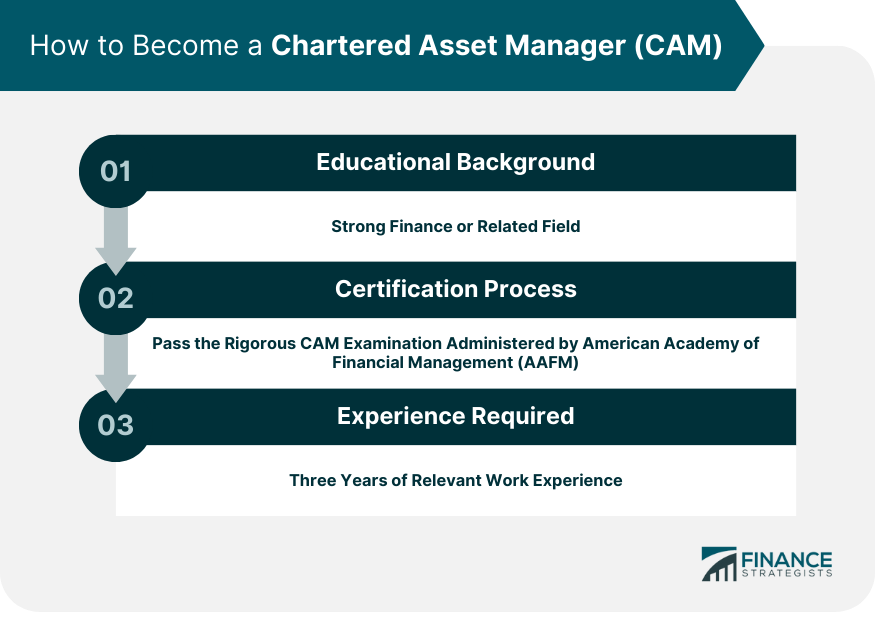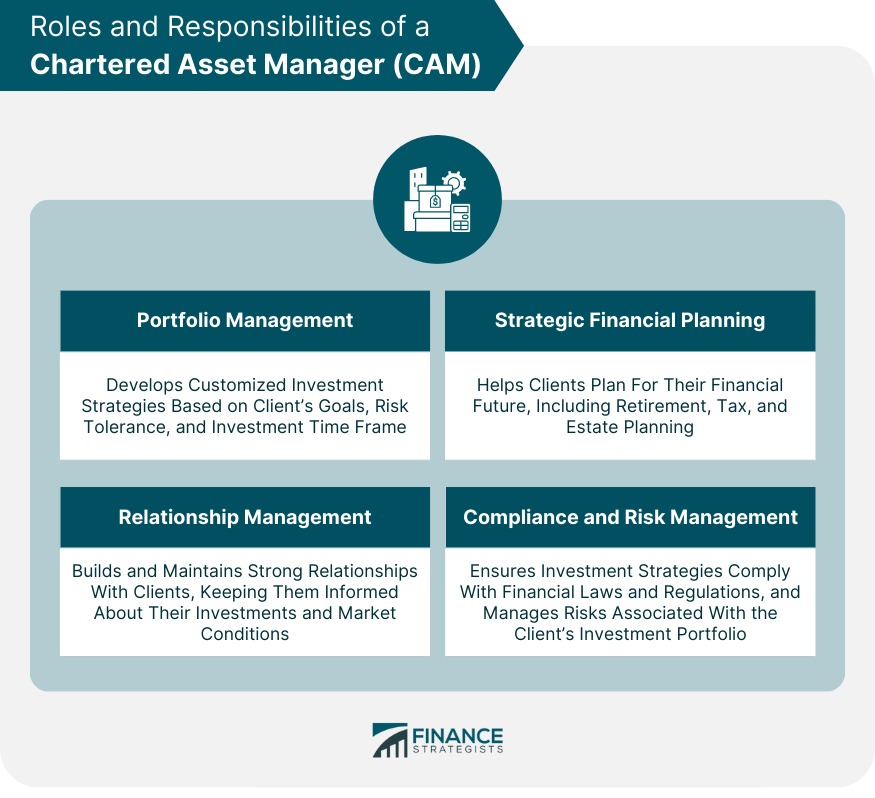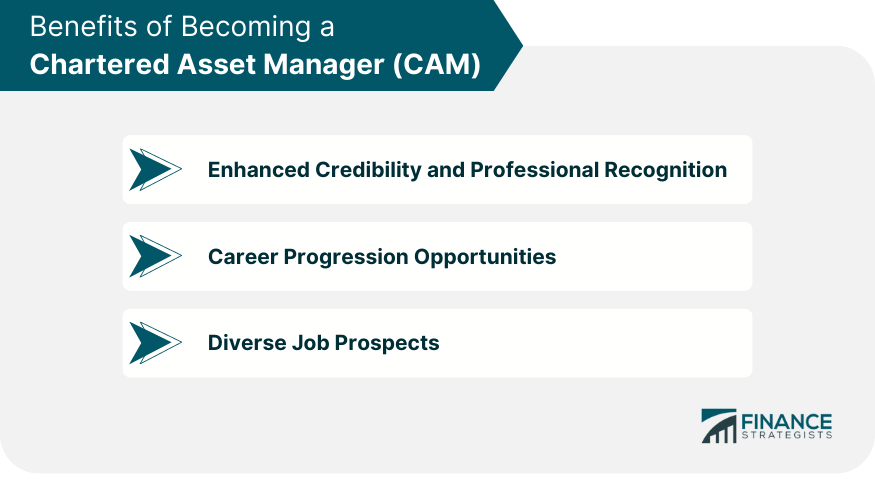A Chartered Asset Manager (CAM) is a respected professional title awarded by the American Academy of Financial Management (AAFM). This designation is for finance professionals who excel in managing high-value assets and portfolios. Achieving the CAM certification denotes profound knowledge in asset, risk, and wealth management, setting a standard of excellence in the finance industry. Beyond showcasing an individual's grasp of advanced financial strategies, the CAM emphasizes judgement and discretion in decision-making for clients. This designation enhances a professional's credibility in asset management and financial planning. It not only signifies expertise but also a commitment to high ethical standards. For clients, a CAM advisor represents both expertise and ethical assurance, vital when dealing with significant assets. To become a CAM, an individual needs to have a strong educational background in finance or a related field. Most candidates have a bachelor's degree, and many have advanced degrees in finance, economics, or business administration. Certain certifications also require candidates to complete specific coursework in asset management and finance before they can be eligible to take the CAM examination. This preparatory process ensures a thorough grounding in the essentials of asset management. The AAFM administers the CAM examination. Candidates must pass this rigorous test, which covers topics such as investment management, risk management, estate planning, and ethical issues in finance. After passing the examination, candidates receive their CAM designation and are officially recognized as Chartered Asset Managers. This process ensures that all CAMs have a uniform level of knowledge and expertise. Experience is a critical component in the journey to becoming a CAM. The number of years of experience required to become a CAM depends on the certification and licensure process that one follows. To qualify for the CAM examination, candidates must have at least three years of relevant work experience in asset management or finance. This experience must be verified by a supervisor or a peer who holds a similar or higher-level certification. Such hands-on experience allows CAMs to apply theoretical knowledge to real-world situations, making them well-equipped to deal with the various challenges that can arise when managing assets. Portfolio management involves developing a customized investment strategy for each client. A CAM analyzes the client's financial goals, risk tolerance, and investment time frame, and then constructs an investment portfolio that aligns with these factors. The ultimate goal is to maximize the client's return on investment while managing risk and volatility effectively. In addition to managing investments, a CAM provides strategic financial planning services. They help clients plan for their financial future, including retirement planning, tax planning, and estate planning. This involves a detailed analysis of the client's current financial status, as well as their future income and expenditure patterns. A CAM will then develop a personalized financial plan to help clients achieve their financial goals. A significant part of a CAM's role is building and maintaining strong relationships with clients. This involves regular communication to keep clients informed about their investments and the overall market conditions. Through constant interaction, CAMs can understand their clients' changing needs and expectations, allowing them to make necessary adjustments to investment strategies. Compliance with financial laws and regulations is a crucial aspect of a CAM's role. They must ensure all investment strategies and financial plans are in line with current laws. In addition, a CAM is responsible for identifying, assessing, and managing the risks associated with a client's investment portfolio. This involves continuously monitoring market trends and economic indicators to anticipate potential risks and take timely action to mitigate them. A CFP primarily provides financial planning services, including retirement planning, tax planning, and estate planning. While a CAM can also offer these services, their focus is more on managing and growing high-value investment portfolios. Therefore, for those seeking a career primarily in asset management, the CAM may be a more suitable option. The CAM offers a more in-depth focus on asset management techniques and strategies, making it particularly suitable for those looking to manage substantial portfolios. The CFA designation is highly respected in the finance industry, particularly in the field of investment analysis. However, the CAM has a more specific focus on asset management, making it an excellent choice for professionals who want to specialize in managing high-value portfolios. The CAM provides a more targeted skill set for those who want to excel in this particular niche, making it a competitive choice when compared to the more generalist CFA designation. The CAM certification is an internationally recognized qualification. It signifies that an individual has a high level of knowledge and expertise in asset management, which can significantly enhance their professional credibility. With the CAM title, professionals demonstrate their commitment to continuous learning and adhering to high standards of practice, which can go a long way in building trust with clients and colleagues alike. CAM certification can open up numerous career advancement opportunities. Professionals with a CAM designation can rise to senior positions in asset management, hedge funds, private banking, and financial advisory services. The knowledge and skills acquired through the CAM certification can position professionals for leadership roles, where they can influence strategic decisions and contribute significantly to organizational success. The CAM certification equips professionals with skills that are highly sought after in the finance industry. This provides them with a broad range of job prospects, allowing them to work in various sectors, such as asset management firms, banks, insurance companies, and wealth management firms. With a CAM designation, professionals have the flexibility to move across different sectors within the financial industry, thereby enhancing their career prospects. CAMs use their knowledge and skills to develop investment strategies that aim to maximize wealth accumulation for their clients. This often involves managing a diverse range of assets, including stocks, bonds, real estate, and other investments. By strategically allocating assets and periodically adjusting the portfolio based on market conditions, CAMs can optimize the returns on their clients' investments. Managing risk is a crucial part of a CAM's role. They assess the client's risk tolerance and then allocate assets accordingly to ensure that the client's portfolio aligns with their risk tolerance and investment goals. By understanding the nuances of different asset classes and how they correlate with each other, CAMs can create a well-diversified portfolio that can weather market volatility while achieving the desired returns. Many CAMs also provide estate planning services. This can involve setting up trusts, drafting wills, and devising strategies to minimize estate taxes. By effectively managing these aspects, a CAM can help ensure the seamless transition of wealth to the next generation, thereby preserving the financial legacy of their clients. Continuing education helps CAMs stay updated with the latest developments in the financial sector. This can involve participating in workshops, attending seminars, or enrolling in advanced courses. By constantly updating their knowledge, CAMs can provide their clients with the most relevant and effective financial strategies. Networking plays a significant role in a CAM's career development. Attending industry conferences and participating in professional organizations can help CAMs connect with other professionals in their field, gain new insights, and even find new job opportunities. Such interactions can also lead to collaborations and knowledge sharing, which can be incredibly valuable in the dynamic world of finance. In an ever-evolving financial landscape, the role of a Chartered Asset Manager (CAM) has never been more critical. Recognized by the American Academy of Financial Management (AAFM), the CAM designation underscores an individual's unparalleled expertise in managing high-value assets, coupled with an unwavering commitment to ethical standards. This professional journey is steeped in rigorous educational requirements, relevant hands-on experience, and a meticulous certification process. A CAM's roles, ranging from portfolio and strategic financial planning to relationship management and risk compliance, underscore the breadth of their responsibility. Moreover, in comparing CAM to other financial designations like CFP and CFA, it's evident that CAM offers a specialized focus tailored for asset management. The benefits of achieving this prestigious title are manifold, promising enhanced professional credibility, career progression, and diverse job opportunities. For clients, partnering with a CAM ensures strategic asset management, optimal wealth accumulation, and efficient estate planning. Understanding the Chartered Asset Manager
Journey to Becoming a CAM
Educational Requirements
Certification and Licensure Process
Experience Required

Roles and Responsibilities of a CAM
Portfolio Management
Strategic Financial Planning
Relationship Management
Compliance and Risk Management

CAM vs Other Financial Designations
Certified Financial Planner (CFP)
Chartered Financial Analyst (CFA)
Benefits of Becoming a CAM
Enhanced Credibility and Professional Recognition
Career Progression Opportunities
Diverse Job Prospects

Impact of CAM on Client Wealth Management
Importance in Wealth Accumulation
Role in Risk Management and Asset Allocation
Contribution to Estate Planning
Continuous Professional Development for CAMs
Ongoing Education
Networking Opportunities
Final Thoughts
Chartered Asset Manager (CAM) FAQs
A CAM is a professional designation indicating expertise in managing high-value assets and portfolios, and it's awarded by the American Academy of Financial Management (AAFM).
A CAM's responsibilities include portfolio management, strategic financial planning, relationship management, compliance, and risk management.
While all three are respected in finance, a CAM focuses on asset management, a CFP on financial planning, and a CFA on investment analysis.
Benefits include enhanced credibility, professional recognition, career progression opportunities, and diverse job prospects within the finance industry.
CAMs manage wealth accumulation, risk management, asset allocation, and estate planning, providing clients with a comprehensive wealth management solution.
True Tamplin is a published author, public speaker, CEO of UpDigital, and founder of Finance Strategists.
True is a Certified Educator in Personal Finance (CEPF®), author of The Handy Financial Ratios Guide, a member of the Society for Advancing Business Editing and Writing, contributes to his financial education site, Finance Strategists, and has spoken to various financial communities such as the CFA Institute, as well as university students like his Alma mater, Biola University, where he received a bachelor of science in business and data analytics.
To learn more about True, visit his personal website or view his author profiles on Amazon, Nasdaq and Forbes.















